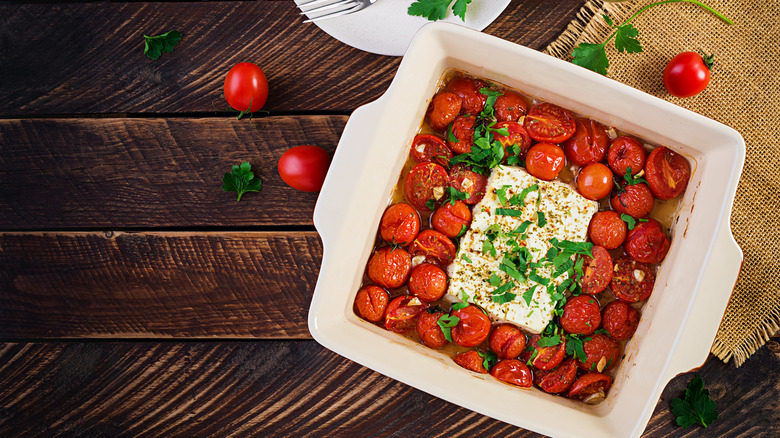The Erasure Problem With Viral TikTok Recipes
If you thought that a social media platform where your success is largely based on a video's likelihood to be replicated thousands of times wouldn't have an issue with authorship and accreditation ... well, you'd be wrong. TikTok — that treasure trove of trends that kids love and adults struggle to understand — has faced considerable backlash over the past year for its problematic algorithms (like the ones that suppress creators who identify as fat, queer or disabled, according to Slate), and its inequitable treatment of creators of color (via Forbes).
The platform has also faced criticism for creating a culture in which the original choreographer of a given dance craze is often overlooked in favor of a more famous (often, white) interpreter of said dance, as The New York Times reported. But surely, you may think, the culinary space is different. However, just because everyone eats doesn't mean that everyone is represented equally on social media.
Brands pledged to do better, but did they?
When it comes to viral TikTok recipes, Food & Wine writer Reina Gascon-Lopez laments that many of the dishes that go viral are, on a scale of one to 10 ...just okay. Take the baked feta pasta that took TikTok by storm, for example. Though part of the appeal was its simplicity, feedback from places like Delish seem to indicate that a whole lot more work (and ingredients) was needed to bring the dish up to snuff. And, Gascon-Lopez argues, chefs and cooks of color don't always have the latitude to put in so little effort for so big a return.
As Gascon-Lopez explains, "The majority of the people who have made viral foods viral are white or white-passing; particularly when it comes to foods and cuisines that originate from other ethnic groups." Whether they are on TikTok, Instagram, or good old-fashioned Facebook, viral food trends are "centered on whiteness and being palatable to the masses," Gascon-Lopez claims. As such, she argues, there is an obvious lack of diversity at best, and undertones of cultural appropriation and racism at worst.
Though this deficit in representation certainly isn't new, it informed national conversation after the Black Lives Matter protests in the summer of 2020, and companies — including social media platforms — took note. Brands and businesses pledged to do better, to diversify, and to pass the mic to more people of color.
Culinary space is the perfect opportunity for diversity of representation
So what do their report cards look like in 2021? "Nothing has changed," according to Food & Wine's Gascon-Lopez. "Most brands and companies will instead take the time to simply disable comments on their social media posts that feature Black and brown creators, rather than mediate and address their rabid fanbase from spewing racist vitriol."
Ironically, food offers an incredible opportunity to lift and amplify stories from the BIPOC community. When a recipe video goes viral — whether because the dish is easy to make, the result is delicious, or simply because the video itself was well produced — the author of the video is treated to 15 minutes (or seconds) of fame. The visual component of social media offers viewers a chance to see more Black and brown hands creating and cooking. The story behind the recipe itself can be an invitation to learn more and engage in meaningful conversation about the person and the culture behind a recipe, as Food & Wine points out.
The problem is that this exposure and the ensuing dialogue is just not happening for BIPOC with the same consistency (or volume) that it does for white people. And until it does, TikTok gets the same report card comment that many of its young users are probably very familiar with: Just not living up to its full potential.


